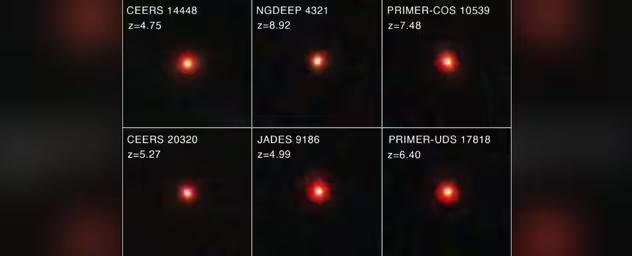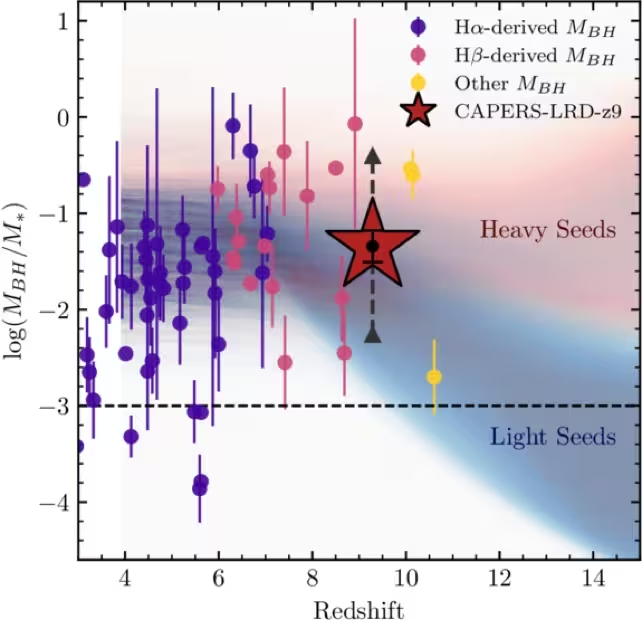6 Minutes
Discovery of the most distant confirmed black hole
Astronomers have confirmed the most distant and earliest supermassive black hole yet identified, embedded in a compact, red galaxy cataloged as CAPERS-LRD-z9. Observations indicate the central black hole already weighed roughly 300 million times the mass of the Sun when the Universe was only about 500 million years old — roughly 3 percent of its current age. This finding pushes the observational frontier for massive black holes into Cosmic Dawn and offers a credible physical explanation for an enigmatic population of objects recently detected by the James Webb Space Telescope (JWST).
The central engine in CAPERS-LRD-z9 behaves as an active galactic nucleus (AGN): a black hole that is accreting gas rapidly and producing intense radiation. Because the accretion region is shrouded in dust and heated gas, the object appears very red in JWST’s infrared images, matching the visual appearance of the so-called Little Red Dots (LRDs) that have puzzled researchers since they first appeared in early JWST surveys.
Spectroscopy, gas speeds, and the smoking gun
Spectroscopic data provided the critical confirmation. By dispersing the incoming light into a spectrum, astronomers measured Doppler shifts in emission lines produced by gas near the nucleus. The gas is moving at extraordinary speeds — roughly 3,000 kilometers per second, or about 1 percent of light speed — indicative of the enormous gravitational pull of a supermassive black hole. Such broad, fast-moving emission-line profiles are hard to reproduce by other astrophysical processes, making spectroscopy a decisive tool for identifying AGN in the early Universe.
Anthony Taylor, lead author and astrophysicist at the University of Texas at Austin, emphasizes that the spectral signature is distinctive and that this confirmation is at the current practical observational limit for high-redshift black hole searches. JWST’s infrared sensitivity is critical here: light from Cosmic Dawn is stretched by the expanding Universe into the infrared, allowing JWST to detect and characterize sources that were invisible to previous instruments.

LRDs, mass ratios, and implications for early galaxy growth
Little Red Dots emerged as a class from JWST deep-field imaging: unusually bright, compact, and very red sources that appear at epochs corresponding to roughly 600 million years after the Big Bang and then largely fade from view by one billion years. The spectroscopic confirmation that CAPERS-LRD-z9 hosts a powerful AGN supports the idea that many LRDs are galaxies dominated by rapidly growing, dust-enshrouded supermassive black holes.
The inferred black hole mass in CAPERS-LRD-z9 is exceptional not only in absolute terms but also relative to its host galaxy. At roughly 300 million solar masses, the black hole may comprise a sizable fraction — possibly around half — of the galaxy’s total stellar mass. In contrast, supermassive black holes in the nearby Universe are typically only about 0.1 percent of their host galaxies’ stellar mass. Such disproportionate black hole-to-galaxy mass ratios suggest that very early galaxies underwent a different co-evolutionary path, where black hole growth could temporarily outpace star formation.
CAPERS-LRD-z9 itself is extremely compact. Even with JWST’s sharp infrared imaging, it remains unresolved and appears no larger than approximately 1,140 light-years across, placing it in the size range of dwarf galaxies rather than mature spirals.
How could such a massive black hole form so early?
Researchers consider two broad growth scenarios starting from seed black holes. If the seed was already heavy — on the order of 10,000 solar masses — sustained accretion at the Eddington limit (the theoretical steady growth rate where radiation pressure balances gravity) could explain the observed mass within 500 million years. Alternatively, the seed could have been much smaller (around 100 solar masses) but then experienced super-Eddington accretion — brief episodes of extremely rapid, radiatively inefficient growth, possibly aided by a dense gas envelope that traps radiation.
Potential origins for large seeds include primordial black holes formed in the early Universe, direct collapse of massive primordial gas clouds, runaway stellar collisions within dense clusters, or remnants of Population III stars — the first generation of metal-free stars. Distinguishing among these pathways will require statistical samples of early AGN and tighter constraints on host-galaxy properties.

Broader context, technology limits and future prospects
This discovery demonstrates JWST’s ability to probe black hole growth during Cosmic Dawn and to link these engines to the emergent population of LRDs. Yet the result also highlights observational limits: beyond this redshift range, detecting and confirming black holes becomes increasingly challenging with present instruments. As Taylor notes, these observations are pushing the boundaries of what current technology can detect, implying that advances in sensitivity, spectral resolution, and survey area will be needed to expand the census of early AGN.
Future JWST programs, combined with next-generation facilities such as the Extremely Large Telescope (ELT) and planned X-ray missions, will help map how frequently overmassive black holes appeared in the first billion years and whether LRD-like phases represent a transient stage in galaxy assembly. Understanding that relationship is essential for reconstructing how typical galaxies — including the Milky Way — built up their stellar content while simultaneously growing central black holes.
Conclusion
The spectroscopic confirmation of a roughly 300-million-solar-mass black hole in CAPERS-LRD-z9 extends the known population of supermassive black holes into Cosmic Dawn and offers a plausible physical explanation for the Little Red Dots seen by JWST. The object’s extreme mass and compact host galaxy imply rapid, early black hole growth that can dominate a galaxy’s mass budget, challenging conventional models of black hole–galaxy co-evolution. Continued infrared spectroscopy and broader surveys will be essential to determine whether CAPERS-LRD-z9 is an outlier or representative of a common, but brief, phase in the Universe’s first billion years.
Source: iopscience.iop


Leave a Comment